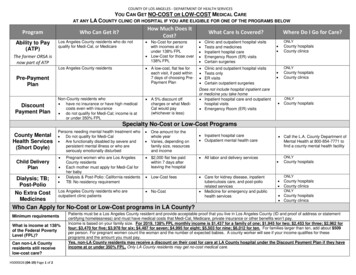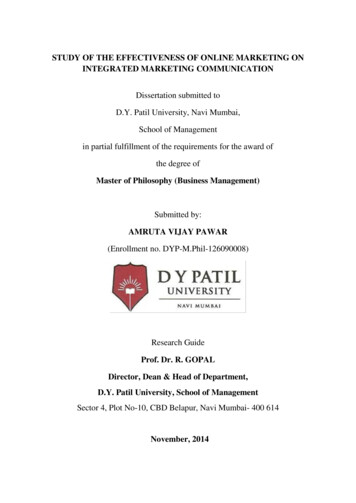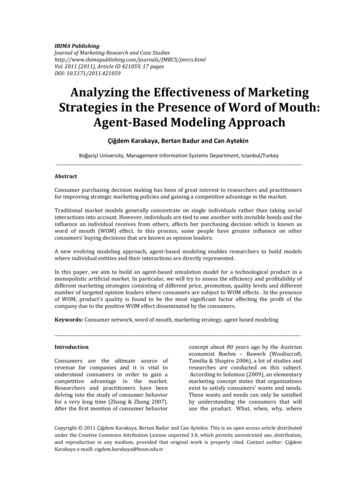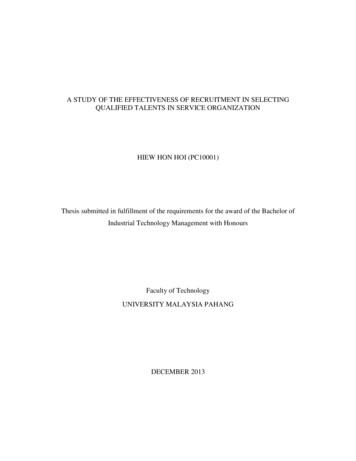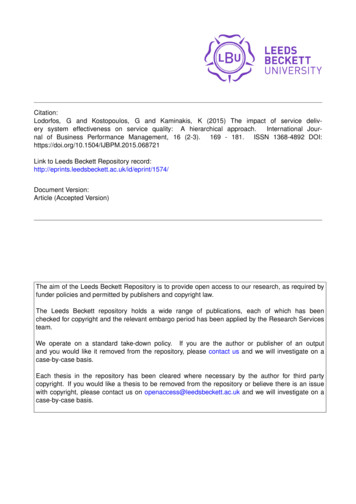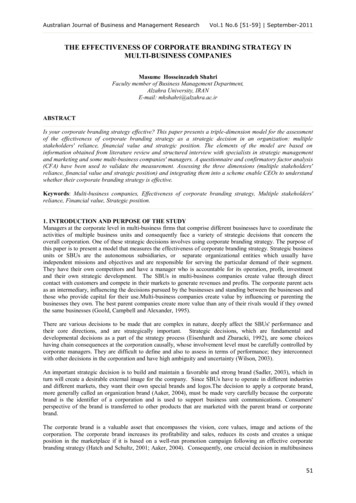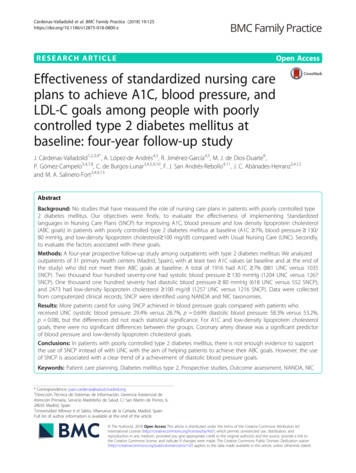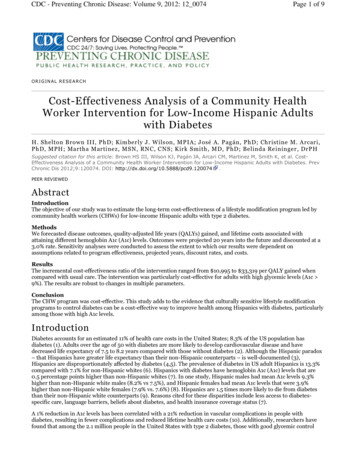
Transcription
CDC - Preventing Chronic Disease: Volume 9, 2012: 12 0074Page 1 of 9O R I GI N A L R ES E A R CHCost-Effectiveness Analysis of a Community HealthWorker Intervention for Low-Income Hispanic Adultswith DiabetesH. Shelton Brown III, PhD; Kimberly J. Wilson, MPIA; José A. Pagán, PhD; Christine M. Arcari,PhD, MPH; Martha Martinez, MSN, RNC, CNS; Kirk Smith, MD, PhD; Belinda Reininger, DrPHSuggested citation for this article: Brown HS III, Wilson KJ, Pagán JA, Arcari CM, Martinez M, Smith K, et al. CostEffectiveness Analysis of a Community Health Worker Intervention for Low-Income Hispanic Adults with Diabetes. PrevChronic Dis 2012;9:120074. DOI: http://dx.doi.org/10.5888/pcd9.120074 .PEER REVIEWEDAbstractIntroductionThe objective of our study was to estimate the long-term cost-effectiveness of a lifestyle modification program led bycommunity health workers (CHWs) for low-income Hispanic adults with type 2 diabetes.MethodsWe forecasted disease outcomes, quality-adjusted life years (QALYs) gained, and lifetime costs associated withattaining different hemoglobin A1c (A1c) levels. Outcomes were projected 20 years into the future and discounted at a3.0% rate. Sensitivity analyses were conducted to assess the extent to which our results were dependent onassumptions related to program effectiveness, projected years, discount rates, and costs.ResultsThe incremental cost-effectiveness ratio of the intervention ranged from 10,995 to 33,319 per QALY gained whencompared with usual care. The intervention was particularly cost-effective for adults with high glycemic levels (A1c 9%). The results are robust to changes in multiple parameters.ConclusionThe CHW program was cost-effective. This study adds to the evidence that culturally sensitive lifestyle modificationprograms to control diabetes can be a cost-effective way to improve health among Hispanics with diabetes, particularlyamong those with high A1c levels.IntroductionDiabetes accounts for an estimated 11% of health care costs in the United States; 8.3% of the US population hasdiabetes (1). Adults over the age of 50 with diabetes are more likely to develop cardiovascular disease and havedecreased life expectancy of 7.5 to 8.2 years compared with those without diabetes (2). Although the Hispanic paradox– that Hispanics have greater life expectancy than their non-Hispanic counterparts – is well-documented (3),Hispanics are disproportionately affected by diabetes (4,5). The prevalence of diabetes in US adult Hispanics is 13.3%compared with 7.1% for non-Hispanic whites (6). Hispanics with diabetes have hemoglobin A1c (A1c) levels that are0.5 percentage points higher than non-Hispanic whites (7). In one study, Hispanic males had mean A1c levels 9.3%higher than non-Hispanic white males (8.2% vs 7.5%), and Hispanic females had mean A1c levels that were 3.9%higher than non-Hispanic white females (7.9% vs. 7.6%) (8). Hispanics are 1.5 times more likely to die from diabetesthan their non-Hispanic white counterparts (9). Reasons cited for these disparities include less access to diabetesspecific care, language barriers, beliefs about diabetes, and health insurance coverage status (7).A 1% reduction in A1c levels has been correlated with a 21% reduction in vascular complications in people withdiabetes, resulting in fewer complications and reduced lifetime health care costs (10). Additionally, researchers havefound that among the 2.1 million people in the United States with type 2 diabetes, those with good glycemic control
CDC - Preventing Chronic Disease: Volume 9, 2012: 12 0074Page 2 of 9(A1c 7 or less) had direct diabetes-related medical costs that were 16% lower than those with fair glycemic control (A1c 7 - 9) and 20% lower than those with poor glycemic control (A1c 9) (11).Community health workers (CHWs) are effective in motivating sustained lifestyle changes in Hispanics with diabetes.CHW interventions improve knowledge about this chronic health condition (12,13), self-management (13–15), and self-efficacy (13). CHW interventions have also resulted in significant reductions in A1c levels (12,13,15,16). Althoughresearch has analyzed the cost-effectiveness of CHW-based diabetes management interventions delivered in primarycare settings (17,18), we know of no cost-effectiveness studies of diabetes self-care interventions that involve CHWsdelivering home-based counseling and education. Given this population’s lack of access to traditional health careservices, the provision of home-based diabetes self-management education is likely to add substantial value to, andimprove the effectiveness of, diabetes management initiatives. However, program delivery in patient homesnecessitates added costs. This study analyzes the cost-effectiveness of a diabetes management intervention forHispanics delivered in both primary care and home settings. The objective of our study was to estimate the long-termcost-effectiveness of a lifestyle modification program led by community CHWs for low-income Hispanic adults withtype 2 diabetes.MethodsPriority populationThe priority population for this study was Hispanic adults aged 18 years or older with type 2 diabetes who werepatients at the Mercy Clinic in Laredo, Texas, from October 2009 to January 2010. Laredo is in south Texas on theMexico border, in Webb County. About 96% of the population of Webb County is of Hispanic origin, and medianhousehold income is 37,140 (19). Almost half of adults aged 18 to 64 in the Laredo metropolitan statistical area(MSA) lack health insurance coverage (20).Analysis inclusion prerequisites were a diagnosis of type 2 diabetes, availability of baseline and follow-up A1c readings,and evidence of program participation. Forty-six participants met these criteria. Of the 46, 16 had baseline A1c levels ator below 7%, indicating good glycemic control, and were therefore excluded from the study group. The sampleanalyzed consists of the remaining 30 participants.Intervention componentsThe University of Texas Community Outreach (UTCO) intervention is an ongoing community-based diabeteseducation and self-management program that uses community partnerships and trained CHWs to reach participants.Four Texas counties, including Webb County, host UTCO programs. We used first-wave evaluation data (follow-updata collected through January 15, 2011) from the Webb County UTCO program for this analysis.Mercy Clinic, the primary Webb County partner in the UTCO program, provides primary health care, health education,and social services to the financially disadvantaged and medically underserved population. Intervention componentsinclude home-based CHW visits, classroom health education classes, nutrition classes, exercise classes, and counselingsessions. The nutrition classes teach new diabetes management skills. Exercise classes provide venues and socialsupport for physical activity. Counseling sessions provide targeted guidance on individual issues participants have inmanaging their diabetes. Home visits provide reinforcement of themes covered in classes and support in creating cuesto action. CHWs bring schedules of upcoming classes to home visits, provide guidance on which sessions participantsshould give priority to, and assist participants in overcoming barriers related to effective diabetes management.Five state-certified CHWs and a nurse educator are the primary UTCO service providers. Four of the 5 CHWs werepreviously employed by Mercy Clinic, and external funding of the UTCO program covered the project director’s salaryand enabled hiring of a fifth CHW and a nurse practitioner. CHWs received training through the UT Health ScienceCenter School of Public Health, Brownsville Regional Campus, on leading nutrition and exercise classes and on datagathering protocols. All CHWs, who are called promotoras in the Hispanic community, are certified through the TexasDepartment of Health and Human Services’ CHW training program. The CHWs’ primary role is to developrelationships with participants to provide individualized guidance, one-on-one diabetes education, and counselingaimed at increasing participants’ ability and self-efficacy to manage their diabetes. Additionally, CHWs and the nurseeducator teach participants in group environments how to manage their diabetes, improve their nutrition, and loseweight. Several volunteers, including a dietitian, a certified Zumba instructor, and students from Texas A&MInternational University (TAMIU), assist with teaching nutrition classes, leading exercise classes, and facilitatinggroup counseling sessions.To be included in the analysis, participants had to have received at least 1 home visit in addition to having a baselineA1c reading above 7.0. We set these criteria for several reasons 1): many people attended classes only, and our primaryfocus was the combination of CHWs in clinical (classes) and community (home) settings; 2) home visits are the mostexpensive component of the intervention, and we wanted to include these costs in our analysis; 3) we hypothesizedthat these in-home activities would be key components to the program’s success and to sustained outcomes; and 4) the
CDC - Preventing Chronic Disease: Volume 9, 2012: 12 0074Page 3 of 9agreement between Mercy Clinic and participants included attendance at both classes and home visits. All participantsattended nutrition and health education classes (mean number of classes attended, 8.3); 77% attended exercise classes(mean number of classes attended, 4.2); and 33% attended counseling sessions (mean number of sessions attended,4.3). Follow-up A1c readings were taken periodically, ranging from 37 to 565 days (mean, 75 days) for the sample.CostsWe assessed the cost-effectiveness of the UTCO intervention in this location from a societal perspective. The societalperspective includes all measurable opportunity costs, representing all groups affected by a program. To assessprogram costs, we included staff time and valuation of volunteer and participant time for home visits, educationalclasses, counseling sessions, exercise classes, class-related materials, and mileage related to home visits.Mercy Clinic paid staff salaries and for program supplies. We used the Bureau of Labor Statistics Metropolitan andNon-Metropolitan Area Occupational Employment and Wage Estimates for the Laredo MSA (21) to value volunteerand participant time. Where volunteer occupation was known (eg, dietitian), we used the mean wage for thatoccupation, and we included the value of fringe benefits and taxes for clinic staff and volunteers. We used the Texasminimum wage ( 7.25 hourly) to value student volunteer time and the average hourly wage rate for the Laredo MSA( 16.14) to value the time of study participants. This average rate was likely higher than what study participants wereearning in their jobs. We added only Federal Insurance Contributions Act (FICA) taxes to participant base wages. Tocalculate the average cost per home visit, we used information gathered from CHW interviews about the typical lengthof a home visit, the time needed to schedule visits, and travel time to and from appointments. Estimated averagemileage expense was assessed at 0.51 per mile. Initial home visits took, on average, twice as long as subsequent visitsbut involved the same amount of scheduling and travel time; we factored this into total home visit expenses andassigned a value of 80.59 for initial home visits and 48.16 for follow-up visits.We calculated a composite fixed cost per class from information gathered from Mercy Clinic records on time andresources needed to deliver each type of class. We weighted the cost for each type of education class by the frequencywith which the class was offered and summed them to derive an average class cost. We similarly developed compositeper-session fixed costs for exercise classes and counseling sessions. Total costs for each activity category were the sumof the fixed costs of the classes and aggregate attendee time costs. This composite fixed cost was multiplied by the totalnumber of classes or sessions; to this product we added the average attendance and the per-participant time cost ofattendance to derive the time costs of attendees. Ten percent of the total CHW training expense was included in theintervention costs. The time costs for staff, volunteers, and participants; the class and session time; mileage costs;resource costs; and the CHW training expenses were summed to derive a total program cost for the sample, resultingin a per-participant program cost of 1,175.63 for the 18-month period. These cost calculations ignore economies ofscale that would accrue from the program being run at a capacity more reflective of real-world situations. To create areal-world cost structure, we used the original fixed and variable costs for each activity, but increased averageattendance levels to reflect data collected on actual class attendance (ie, which included participants not used in thesample); we then calculated intervention costs based on the prevalence of diabetes in the Archimedes Model(Archimedes, Inc, San Francisco, California) (n 6,551) (Table 1).Finally, because diabetes management is a long-term process, we estimated ongoing postintervention costs assumingcontinued participation in educational classes, counseling, and exercise activities at 50% of intervention levels over the3 periods of our projections (5, 10, and 20 years). This resulted in annual post-intervention costs of 140.63 perparticipant. We used data from the 2006 Medicare Current Beneficiary Survey for medical costs (22); lifestyle changecosts were taken from a systematic review of costs of major US commercial weight loss programs (23).Projecting outcomes and medical costsWe used the Archimedes model to project the intervention’s incremental lifetime health outcomes and relatedexpenditures based on changes in A1c levels. It simulates the effects of interventions by generating multiyear forecastsof predicted disease outcomes, health behaviors, and health care costs relative to a hypothetical control group withsimilar demographic characteristics. Studies have independently validated the model for diabetes outcomes research(24).We applied data from the Archimedes Cardio-Metabolic Risk (CMR) dataset, which includes data from a simulated USrepresentative sample of 100,000 people aged 30 to 85 years (25) to our study sample of 6,551. The CMR datasetincludes the results of 19 simulated controlled clinical trials comparing standard care (defined as current levels of carein the US population) with a set of health management interventions targeting cardio-metabolic risk, includingglycemic control (25).For the primary analysis, we grouped study participants into 2 cohorts: those whose diabetes was brought undercontrol (ie, follow-up A1c reading was 7%) and those who were still out of control at follow-up (A1c 7%) (Table 2).During the intervention, the diabetes of 60% of the subjects was brought under control. We assumed that the sample’slevels of glycemic control would fluctuate over time. When A1c becomes uncontrolled, the intervention in the CMR
CDC - Preventing Chronic Disease: Volume 9, 2012: 12 0074Page 4 of 9dataset is designed to bring A1c under control. On the other hand, A1c in the dataset’s control group is uncontrolled atbaseline and can vary over time; however, there is no specific intervention apart from usual care to reduce A1c to atarget level. We discounted program costs, ongoing participation costs, medical costs, and quality-adjusted life years(QALYs) at a 3% rate. Costs are given in 2010 dollars. Archimedes uses disutility weights for diabetes-related disordersand illnesses from 2 studies. One (26) used responses from the 2000-2002 Medical Expenditure Panel Survey (27) andthe EQ-5D questionnaire (28) from a nationally representative sample of 38,678 adults to develop health-relatedquality of life scores for 95 chronic diseases with ICD-9 codes. The other, by Coffey and colleagues (29), used the SelfAdministered Quality of Well-Being index to calculate health utility scores for 2,048 people with type 1 and type 2diabetes. A life-year with none of the 95 chronic diseases present receives a health utility score of 1; the presence of 1 ormore of the chronic diseases reduces the score in accordance with its additive contribution to health disutility.We applied the discount rate to the program and ongoing costs to derive the net present value of intervention costs. Weused the Archimedes simulation model to calculate the long-term differential medical costs and QALYs of people withtype 2 diabetes who do not have access to the program, who we used as controls. We summed the long-term medicalcosts and net present-value intervention costs, subtracted the standard-care medical costs, and divided by thedifference in QALYs between each intervention and the simulated control group to derive incremental costeffectiveness ratios (ICERs).ResultsThe effects of the UTCO intervention are reflected in clinical outcomes for a cohort of participants whose A1c levels atthe beginning of the intervention were above 7%, but fell to 7% or below during the course of the 18-monthintervention (Table 3). We used the real-world cost structure and assumed ongoing annual costs at the 50% level. Onthe basis of our estimates using the Archimedes model, the UTCO intervention is expected to reduce the risk of amyocardial infarction by 2.6%, foot ulcers by 5.6%, and foot amputation by 3.5%. A1c levels will fall by 11.7%, and413.52 life years will be gained through the intervention over a 20-year period. After accounting for health disutilityweights, the UTCO intervention results in an incremental gain of 394.92 QALYs (Table 4).The resultant ICER for a 20-year period was 33,319 per QALY gained for the entire population relative to standardcare (Table 4). The intervention was most cost-effective for those aged 50 to 65 years, with a ratio of 30,786 per QALYgained. The intervention had an ICER of 130,272 per QALY gained over a 5-year period and 56,009 per QALYgained over a 10-year period.We also conducted sensitivity analyses to assess how our results would differ under different assumptions. The resultsstand up to variation for all parameters except when lowering program effectiveness from 60% to 41%, which increasedthe ICER per QALY gained to 51,462. Raising the effectiveness to 73% lowered the ICER to 28,093 per QALYgained. Adjusting the discount rate to 0% and to 6% resulted in ICERs per QALY gained of 30,026 and 37,473,respectively. Finally, lowering annual costs from 50% of program costs to 25% resulted in an ICER of 21,977 perQALY gained; increasing them to 75% resulted in 45,696 per QALY gained.Eighty percent of the cohort that entered the program with an A1c level above 9% lowered their A1c levels to below 9%at follow-up. For this cohort, the ICER was 10,995 per QALY gained. This is largely a function of the long-term healthcare cost savings accrued. Decreasing effectiveness to 60% raised the ICER to 18,680 per QALY gained; raisingeffectiveness to 100% lowered it to 6,384 per QALY gained. Setting the discount rate for costs as well as QALYsgained to 0% lowered the ICER to 9,980 per QALY gained, and setting it at 6% raised the ICER to 12,405 per QALYgained. Finally, lowering continuance costs to 25% lowered the ICER to 2,156 per QALY gained; raising these costs to75% resulted in an ICER of 19,834 per QALY gained.DiscussionThe 20-year cost-effectiveness of the UTCO CHW-based diabetes management program was 33,319 per QALY gainedfor the cohort of low-income Hispanics in our primary analysis. The ratios were 56,009 and 130,272 for the 10- and5-year projections, respectively. Because diabetes is a disease whose full effects occur over the long term, the higherICERs based on shorter term projections are not surprising.From a health care standpoint, interventions to prevent or treat diabetes are
Mexico border, in Webb County. About 96% of the population of Webb County is of Hispanic origin, and median household income is 37,140 (19). Almost half of adults aged 18 to 64 in the Laredo metropolitan statistical area (M



